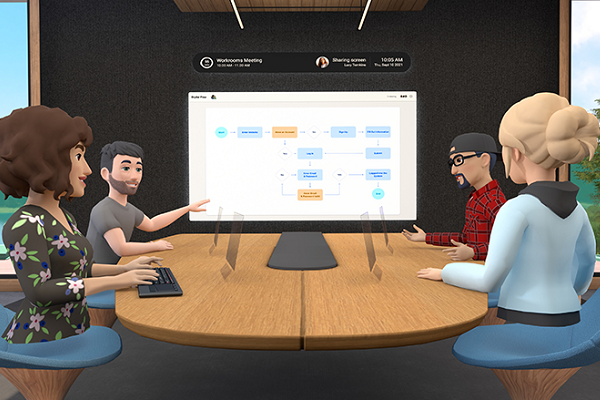Facebook Opens Tests Horizon Workrooms for Virtual Human Offices
 Facebook has begun beta testing the new Horizon Workrooms virtual space for office collaboration. The platform lets users create avatars of themselves and interact with others remotely as though in a physical office using the Oculus Quest 2 headset and other tools. Horizon Workrooms is an early component of the ‘metaverse’ that Facebook CEO Mark Zuckerberg has proclaimed will be his company’s new venture.
Facebook has begun beta testing the new Horizon Workrooms virtual space for office collaboration. The platform lets users create avatars of themselves and interact with others remotely as though in a physical office using the Oculus Quest 2 headset and other tools. Horizon Workrooms is an early component of the ‘metaverse’ that Facebook CEO Mark Zuckerberg has proclaimed will be his company’s new venture.
New Office Horizons
The Facebook Horizon virtual reality platform comes with a toolset for designing a virtual avatar for Workrooms, essentially the same used for its VR games. The cartoonish characters can then move around a similarly animated 3D office, using the physical space represented virtually to interact with others and participate in meetings as though everyone was physically present. The rooms can be customized and shaped to fit whatever the group size and activities require. Those in a VR conference room will be able to speak to each other, with spatial audio imitating hearing people based on where they are in the room. The rooms also come with a virtual whiteboard where users can write and draw collaboratively. The platform uses the sensors and computing power of Oculus headsets to enable the avatar to mimic what the user is doing. Horizon Workrooms is designed for Oculus headsets, but the free platform also supports those exploring the space on their phone or computer. The depth of participation varies depending on the equipment, but the central features are universal.
“More people are working remotely, more people want flexible work options, and more people are re-thinking what it means to be in an office. But without the right connective tools, remote work still has plenty of challenges,” Facebook explained in a blog post. “Workrooms is our flagship collaboration experience that lets people come together to work in the same virtual room, regardless of physical distance. It works across both virtual reality and the web and is designed to improve your team’s ability to collaborate, communicate, and connect remotely, through the power of VR— whether that’s getting together to brainstorm or whiteboard an idea, work on a document, hear updates from your team, hang out and socialize, or simply have better conversations that flow more naturally.”
Virtual Interactions
Facebook is attempting to make an office version of virtual avatar interactions the mainstream after many years and attempts with tools like Second Life. The social media giant may be onto something more concrete now, however. Experiments in the concept started to take on new meaning during the COVID-19 pandemic at conferences and other events. For instance, a virtual Andrew Yang campaigned for mayor of New York City in a digital version of the city on the Zepeto platform. Tech like MetaHuman Creator’s ultrarealistic visuals only reinforces the idea that everyone can make a virtual version of themselves to perform remotely. Synthetic speech tools in tandem with those visuals can even populate those spaces with virtual humans like the Einstein digital clone created this year, and the virtual alter ego YouTube star Taryn Southern created of herself. Facebook is keen to be ahead of the curve on this trend, though how well it can convince people to think of an Oculus headset as the door to their office remains to be seen.
“We’re excited to continue growing the VR for work ecosystem, and we hope that Workrooms serves as inspiration for how these features can work together,” Facebook wrote. “We think VR will fundamentally transform the way we work as a new computing platform, defying distance to help people collaborate better from anywhere.”
Follow @voicebotai Follow @erichschwartz
Andrew Yang Campaigns for NYC Mayor With Virtual Human Avatar
Replica Studios Opens Early Access for Integrating Synthetic Voices into Unreal’s MetaHuman Creator








